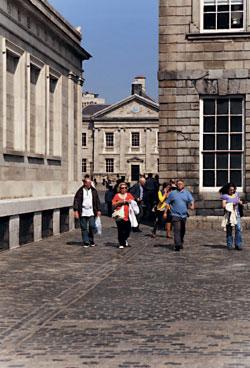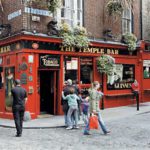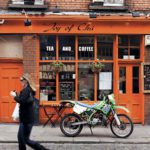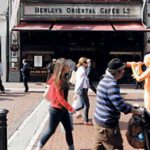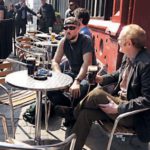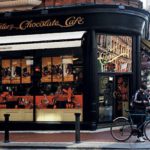Whether you’re in the mood for fine dining or pub grub, Dublin has an array of options
The St Patrick’s Day carnival celebrations in Dublin stretch over a long weekend (16 – 19 March) with a spectacular parade and events ranging from music, film, culture and family fun. Food and drink are the focus at any time of the year in a city with a warm, intimate heart. Most attractions are within walking distance around the centre or just a short ride away on frequent ‘hop on, hop off’ buses. In fact, starting a visit with a bus tour is a good way to fast-track into the multiple layers of the city’s history and culture.
BOOKS AND BOOZE
The Literary Pub Crawl takes in citycentre pubs like Davy Byrne’s Moral pub (so called because the original landlord didn’t drink) in James Joyce’s Ulysses, where Leopold Bloom partakes of a Gorgonzola cheese sandwich and burgundy. The crawl brings Samuel Beckett, James Joyce, Oscar Wilde, Brendan Behan and James Plunkett vividly to life. If you would like to know how Joyce met his future wife, Nora Barnacle, or how Oscar Wilde drank the silver miners of Leadville, Colorado, under the table and have the perfect excuse for drinking, Guinness tour leaders such as Frank and Declan are your men.
The choice of the best pub – always an important debate in Dublin – depends on the company you want to keep. For politicians and pundits there’s Doheny & Nesbitt on Merrion Row; for poets it’s Grogan’s on South William Street; for journalists try Mulligan’s of Poolbeg Street; for traditional music, head to O’Donoghue’s; for the most spectacular view, go to Gravity Bar at the Guinness Storehouse, St James Gate; and for the best Victoriana, try The Long Hall, George’s Street or The Stag’s Head in Dame Lane. Incidentally, creamy-headed Guinness stout really is good for you – Arthur Guinness, founding father of the Guinness Brewery in 1759, had 19 children.
DINING IN DUBLIN
In the past two decades, there has been nothing short of a culinary revolution and Dublin can now justifiably claim to be a foodie city, given its choice of restaurants, markets and specialist food shops, many of which are new post-crisis enterprises.
The Fabulous Food Trail offers a taste of the culture and food around the byways of Dublin: you’ll learn how a gem of a Victorian pub, The Swan Bar on Aungier Street, served as a signalling discover the best crepes and galettes outside France at Fafies on Kevin Street. You’ll also discover how people like brothers Kevin and Seamus of Sheridans Cheesemongers and Marc Armand of the Cocoa Atelier are motivated by sheer passion for good food.
With Dublin’s rich theatre tradition, pre-theatre dinner (expect to pay from 20 – 25 euros for two courses for an early-bird deal) followed by a show makes a great combination. The Gate Theatre on Parnell Square, where Orson Welles started his career, is situated in a corner of The Rotunda (1750), one of the oldest maternity hospitals in the world and just a stroll from Michelin-starred Chapter One Restaurant, appropriately located in the basement of the Dublin Writers Museum.
Or if you want to enjoy part of the legacy of the Celtic Tiger years, there’s the Grand Canal Theatre and the Ely Gastro Pub (try the golden beet and goat’s cheese tart), both spectacularly located beside the Grand Canal Basin.
PERFECT PRAWNS
The entire Grand Canal Basin is lined with tiles like a giant swimming pool, one of the lesser-known facts about Dublin revealed on the Viking Splash Tour. Aboard a yellow amphibious vehicle, grinning passengers don horned helmets, do Viking roars at startled pedestrians and enjoy Dublin humour at its best, in an irreverent commentary that ranges from Dublin’s Viking foundations – the city’s name comes from Dyflin or Duiblinn for ‘black pool’ – to current scandal (such as the prices of swanky Tiger apartments before the developers went bust and they were seized by NAMA, the National Asset Management Agency).
And be warned: you do end up in the Grand Canal Basin. Another highly recommended watery destination is the colourful fishing village of Howth. Travel there by DART, the urban railway line that wraps around Dublin Bay in two scenic arms. It’s the best place to eat or buy fish, with many restaurants and fishmongers lining the West Pier.
Choose from Aqua, Nicky’s Plaice and The Oar House, or pick your favourite fish at the fish counter of Beshoffs before feasting on it at Ivan’s Oyster Bar and Grill on the same premises. Howth is the spot for Dublin Bay prawns, Ireland’s answer to caviar or black truffles Delicately textured andsubtly flavoured, they are in a prawn class all of their own.
Chef at the Pig’s Ear on Nassau Street, Stephen McAllister, offers traditional Irish dishes such as beef-cheek pie with Guinness, beautifully presented in a little copper pan, and brown-bread ice cream with yellow man (honeycomb).
CURIOUSER AND CURIOUSER
There’s a quirkiness and accessibility about Dublin that is altogether beguiling. Within a few streets you can travel centuries or move from architectural feasts to eccentric curiosities. The city has an 18th-century Georgian heart with gracious squares of mellow brick terraces and glorious public buildings like Gandon’s Custom House and Four Courts on the Liffey.
Newman House situated at 85/86 St Stephen’s Green has Georgian plasterwork by Richard West at its most exuberant while 29 Lower Fitzwilliam Street, bought originally for 320 pounds, recreates the lifestyle at the end of the 1700s. Food can turn up in curious places like the ceiling of the chapel at the Royal Hospital, Kilmainham (1680) where cabbages and pumpkins nestle among the decorative swags. The building was inspired by Les Invalides in Paris and is now the home of the Irish Museum of Modern Art.
Among the lesser-known curiosities is Marsh’s Library (1701) where students were locked in cages to read precious books. It’s just around the corner from St Patrick’s Cathedral where Swift of Gulliver’s Travels fame was dean and where that characteristic Dublin expression ‘chancing your arm’ originated. Across the Liffey in Church Street is 17th-century St Michan’s Church where Handel is said to have played the organ, rattling the mummified crusaders who lie in the vaults. In between lies Temple Bar, Dublin’s Left Bank, lined with bars and cafés, where there is a lively food market on Saturdays and Wednesdays in Cow Lane.
Like most old capitals, Dublin is really a series of joined-up villages. The upside of Ireland’s draconian drink/driving laws is that residents now eat and drink locally, restoring a village atmosphere and supporting some seriously good eateries.
Sandymount in Dublin 4 is home to Brownes (another great place for fish), Itsa4, Dunne and Crescenzi and Mario’s around the charming ‘green’. Ranelagh Road, Dublin 6, is lined with restaurants ranging from Asian at Diep Noodles and Punjab Balti, to tapas at La Bodega and bistro at the Wild Goose. And Donnybrook has Dakshin for sophisticated Indian cuisine, Donnybrook Fair Restaurant (also a food hall and cookery school), Tenors Grill Room and O’Connells.
Dubliners have become cappuccino Celts and among the best places to drink coffee are the original Bewley’s Café on Grafton Street and upstairs in the Kilkenny Shop on Nassau Street.
WHERE TO STAY
Dublin currently offers the most reasonable hotel rates anywhere in Europe, perhaps not for long though. For the best places to eat, drink and stay, check out Georgina Campbell’s Ireland Guide at www.ireland-guide.com.
DUBLIN ADDRESS BOOK
- Dublin Bus Tours: www.dublinsightseeing.ie
- Dublin Tourism: www.visitdublin.com
- Fabulous Food Trails: www.fabulousfoodtrails.ie
- Information about fish: http://www.seafoodcircle.ie/
- Viking Splash: www.vikingsplash.com

